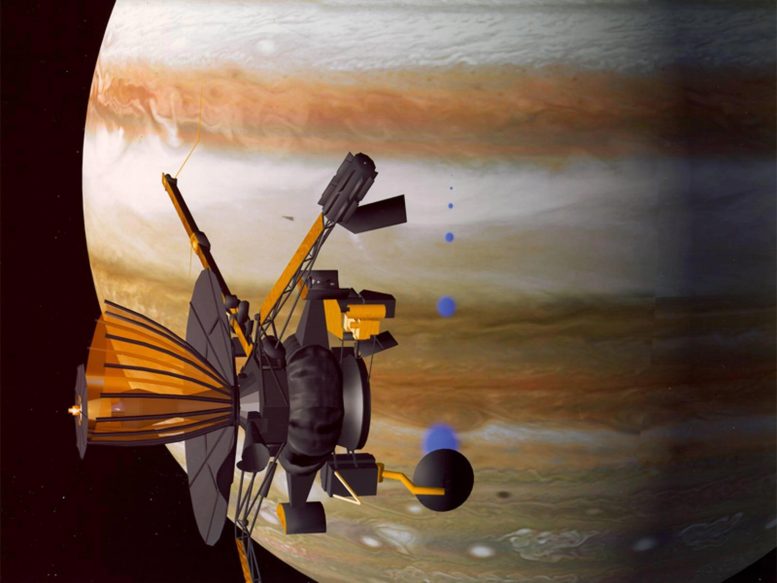
The Galileo spacecraft was launched in 1989 by the space shuttle Atlantis on the STS-34 mission. It arrived at Jupiter on December 7, 1995, a little more than six years later, via gravitational assist flybys of Venus and Earth. Galileo carried 10 science instruments and an atmospheric probe to Jupiter for a comprehensive study of the giant planet’s atmosphere, moons, and magnetosphere from orbit. Galileo was the first spacecraft to orbit Jupiter and launched the first probe into Jupiter’s atmosphere. In 2003, Galileo’s mission was terminated by sending the orbiter into Jupiter’s atmosphere at a speed of nearly 50 kilometers per second to avoid any chance of its contaminating local moons. Credit: NASA/JPL
If any spacecraft could be said to have had nine lives, it was Galileo. At the time of its launch, this mission to Jupiter was the most sophisticated science spacecraft ever built. But the expectation of great science rewards almost was ruined when the spacecraft’s main antenna refused to unfurl. Saving Galileo is the story of how NASA’s Galileo mission — designed, built and operated by NASA’s Jet Propulsion Laboratory — was kept alive despite a multitude of technical challenges, including a years-long launch delay after the loss of the space shuttle Challenger and then the devastating failure of its main antenna following the spacecraft’s launch. It is also the story of a tight-knit team of scientists and engineers who were forged by adversity into what many came to call a family.
Saving Galileo tells how, despite many challenges and limitations, Galileo proved a resounding success.
NASA’s Galileo was an unmanned spacecraft that was launched on October 18, 1989, to study the planet Jupiter and its moons. Named after the famous Italian astronomer Galileo Galilei, the mission was designed to provide a detailed understanding of Jupiter’s atmosphere, magnetosphere, and its diverse satellites.
The spacecraft consisted of two main components: an orbiter and an atmospheric probe. The orbiter was responsible for observing Jupiter and its moons, while the probe was designed to directly enter Jupiter’s atmosphere and relay data back to Earth.
After a long journey through the solar system, Galileo arrived at Jupiter on December 7, 1995, and released its atmospheric probe, which plunged into Jupiter’s atmosphere and transmitted data for about an hour before being destroyed by the intense heat and pressure.
Meanwhile, the orbiter continued its mission, conducting multiple flybys of Jupiter’s largest moons, including Io, Europa, Ganymede, and Callisto. The spacecraft discovered evidence of subsurface oceans on Europa, volcanic activity on Io, and a magnetic field around Ganymede, among other significant discoveries. The mission was extended several times and finally ended on September 21, 2003, when the orbiter was deliberately sent into Jupiter’s atmosphere to prevent potential contamination of the Jovian moons with terrestrial microbes.
JPL and the Space Age Video Series
- Episode 1: The American Rocketeer
- Episode 2: Explorer 1
- Episode 3: Destination Moon
- Episode 4: The Changing Face of Mars
- Episode 5: The Stuff of Dreams
- Episode 6: The Footsteps of Voyager
- Episode 7: To the Rescue
- Episode 8: The Pathfinders
- Episode 9: The Breaking Point
- Episode 10: Saving Galileo
- Episode 11: Mission to Mars
- Episode 12: Landing on Mars
- Episode 13: Triumph at Saturn – Part I
- Episode 14: Triumph at Saturn – Part II


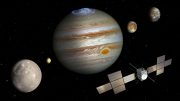
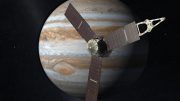
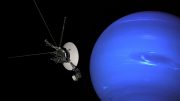
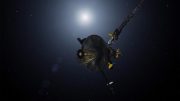
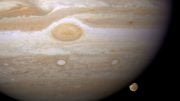
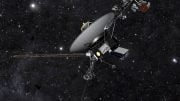
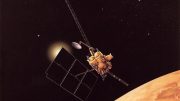
Be the first to comment on "JPL and the Space Age: Saving Galileo (NASA Documentary)"